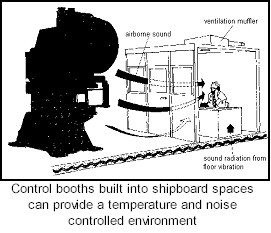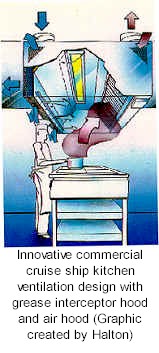Include Improved Ventilation System Design in New Navy Acquisitions
The greatest opportunity for ventilation improvement in future ships is in new ship design power and utilities architecture. For example, the DDX class destroyers are being designed and built to be powered by an electric drive featuring an integrated power architecture. Since the ship architecture will change dramatically with the electric drive technology and with expected reductions in crew sizes, additional space may be available for ductwork, fans, and other ventilation equipment. If the ductwork for shipboard ventilation systems is sized correctly, noise problems due to high air velocity will be eliminated. Assigning ventilation system space allocation as a high priority during ship design will result in increased accessibility for personnel performing ventilation equipment maintenance.
Local Exhaust Ventilation
 Local exhaust is required for processes such as welding and paint mixing and dispensing in paint storage areas. Specialized, portable exhaust blowers are often required for specific temporary projects such as welding or asbestos removal. Local exhaust is required for processes such as welding and paint mixing and dispensing in paint storage areas. Specialized, portable exhaust blowers are often required for specific temporary projects such as welding or asbestos removal.
Consider Human Systems Integration
When designing ventilation systems, it is imperative to take into consideration the needs of personnel living and working aboard ship as well as the work processes performed in particular spaces. The Naval Sea Systems Command (NAVSEA) has increasingly stressed human systems integration (HSI). HSI focuses on identifying task, manpower, and design of equipment and systems to fit users (see the Human Factors Engineering & Ergonomics section of this website)
Ventilation system controls and displays that are difficult to understand may be linked to operating and maintenance problems. Designs that disregard intended usage, maintenance, and repair can be associated with injury to users and inefficient and excessively costly maintenance and preservation. This can and has jeopardized program performance, schedule, and costs. On the other hand, effective designs maximize ease of maintenance, comfort, productivity, and operational effectiveness while protecting operators and maintainers.
Installation of Advanced Food Service Equipment
 Since 1997, the Navy has identified and field-tested several types of advanced food service equipment such as: the combination convection oven/steamer, skittle, and clamshell griddle. Advanced food service equipment can replace multiple pieces of traditional food service equipment. Reducing the amount of equipment in the galley also reduces the need for more complicated ventilation systems and their maintenance. Since 1997, the Navy has identified and field-tested several types of advanced food service equipment such as: the combination convection oven/steamer, skittle, and clamshell griddle. Advanced food service equipment can replace multiple pieces of traditional food service equipment. Reducing the amount of equipment in the galley also reduces the need for more complicated ventilation systems and their maintenance.
Top
Installation of Moisture Separator and Filter at Air-Intakes
The combination of moisture separators, corrosion resistant materials, and new coatings at the ventilation system's air intakes reduces the space cleaning and duct repair burden on the Sailor by limiting corrosion problems.
Installation of Smart Ventilation Monitoring - Condition Based System
Pressure and airflow sensors are used to monitor the function of ventilation systems, including decreased airflow associated with clogging of filters and/or ductwork. Proper design and placement of such monitoring equipment can markedly reduce diagnostic and maintenance costs.
The Navy has field tested a smart, automated, decision support system on ventilation system components that is based solely on operating conditions. This type of support system frees up valuable and limited personnel resources to perform functions and duties other than scheduled maintenance. The wireless monitoring device system uses the shipboard Local Area Network (LAN) to automatically connect the maintenance needs of distributed assets to maintenance technicians through direct interface with the ship's preventive maintenance scheduling software. Monitoring parameters include fan vibration, inlet filter differential pressure, cooling coil differential pressure, air temperatures across the cooling coil, chilled water temperatures across the cooling coil, and fan motor current. Applied expert rules allow for the integration of prognostics so that the system diagnoses itself and schedules its own maintenance when required as well as providing necessary email notification to appropriate personnel.
Note: All of the above recommendations are being addressed in the Navy's new ship design programs such as DD(X), CVN21, LCS, and LHA(R).
Control Booths and Spot Cooling
Fire-room and engine rooms generate so much heat that it is neither practical nor feasible to attempt to reduce temperatures within the entire space. Some ships have built in  sound and temperature control booths in the propulsion spaces which use air conditioning units to re-circulate air and provide comfort for personnel on watch. Outside of these control booths, and aboard those ships without control booths, Navy personnel have immediate access to spot cooling. sound and temperature control booths in the propulsion spaces which use air conditioning units to re-circulate air and provide comfort for personnel on watch. Outside of these control booths, and aboard those ships without control booths, Navy personnel have immediate access to spot cooling.
Spot cooling is a method of providing cooling to personnel in specific locations within a larger very hot area. The ship's fire-room and engine room are examples of very hot areas that can use spot cooling to provide comfort for Sailors working in those spaces.
Effectively placed spot cooling is an extremely efficient means of cooling people, because it directs a high velocity blast of weather air exactly where it is needed. Spot cooling is affected by delivering an envelope of outside air via ventilation ducts and adjustable blast terminals to the respective watch-standers' stations. Due to the high velocity, the incoming air does not rapidly diffuse and mix with the room air. A "cone" of air is provided to watch-standers, even though the Effective Temperature outside the "cone" of air is very high. The key element in spot cooling is an optimal effective air velocity flowing over the worker. This can be best accomplished by positioning the adjustable blast terminal so as to assure a direct, unobstructed air stream at an equitable distance (three to five feet) from the watch-stander's torso.
Top
 New Design Galley Ventilation New Design Galley Ventilation
In the latest galley ventilation design aboard Navy and commercial ships, a high efficiency grease interceptor hood is installed over each grease-generating piece of equipment such as ovens, griddles, and fryers. The grease interceptor hood removes combustion gases, heat, grease, dust, lint, and odors generated from galley cooking operations. Grease, dust, and lint are centrifugally extracted from the air stream within the hood, eliminating fire hazards and maintenance problems due to these contaminants accumulating in the ductwork.
On Navy and commercial cruise ships, the new grease interceptor hood design often has a front supply air plenum, which provides cool and fresh air as needed (see graphic on right). The supply air is distributed at a low velocity forming an air curtain at the front face. This air curtain helps to reduce the effect of the radiant heat on the cook. Commercial cruise ship grease interceptor hoods can also be equipped with Ultra-Violet (UV) technology to overcome potential problems caused by deposits of greasy matter inside the exhaust ducts. The use of UV light starts a chemical reaction in which ozone generated by the lamp reacts with grease and grease vapors, breaking down grease molecules into smaller, harmless compounds. The resulting substance will not stick to the ductwork or the fans, which helps to eliminate the risk of serious fires. This process also reduces maintenance costs.
Installation of Disposable Filters
Use of disposable filters has significant maintenance and manpower advantages. In general, making maintenance easier increases the likelihood that it will get done. Standard air filters aboard ship require time-consuming monthly cleaning. Commercial filters are disposed of when they are dirty, eliminating the need to spend time cleaning old filters. Development, procurement, and installation of improved disposable filters reduce corrosion problems in ventilation systems and result in reduced ventilation maintenance and replacement requirements. Disposable filters are being included in new Navy ship designs.
Top
Installation of Textile Ductwork
Textile ductwork (made of NOMEX fire-retardant material) has been included in new Navy ship designs to replace traditional metal supply air ductwork and air diffusing terminals. Textile ducting provides even air distribution throughout the space. The system is able to achieve this by virtue of the fact that the entire length of the duct is used for discharging the supply air into the conditioned space. Since the airflow is distributed evenly into the space, there are no hot or cold spots and noisy air diffusers in the room. This helps to eliminate unauthorized ventilation system alteration throughout the ship.
Textile ductwork is easy to clean and maintain, which reduces cleanup costs. This type of ducting can be removed and washed in conventional clothes washers at a low labor cost. In addition, textile ductwork is lighter than metal ductwork, resulting in reduced fuel costs.
Installation of Perforated Ductwork
Perforated ductwork is often installed above false ceilings in commercial cruise ship ducting to provide even air distribution throughout the air conditioned space. The space above a false ceiling will work as a supply plenum. Air will be distributed through the perforated duct with low velocity, and the air flows through the ceiling to the room. The perforated ductwork supply air system provides a quiet and effective distribution of conditioned air.
Ventilation System Noise Reduction
Proper ventilation system design and equipment selection can minimize shipboard noise problems and at the same time enhance the service life of equipment. Proper duct sizing for shipboard ventilation systems will eliminate noise problems due to high air velocity. Fans and ductwork are connected by a flexible sleeve to minimize transmitted vibration. Low turbulence and reduced noise duct outlets and diffusers support low noise environments and help meet habitability criteria at minimal cost. |